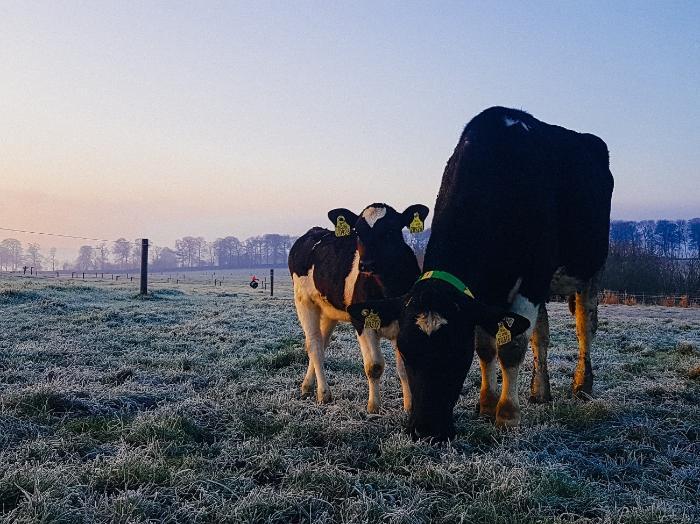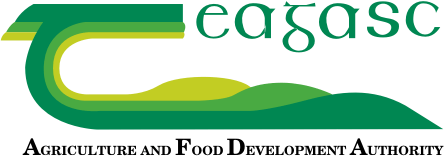10 June 2024
Cow-calf contact systems in Irish dairying

Alison Sinnott, Sarah McPherson, and Emer Kennedy recently undertook an experiment comparing two differing Cow-calf contact (CCC) systems to a more conventional Irish calf rearing system.
Cow-calf contact (CCC) systems allow calves to remain with their mother post-calving and are regarded as a more favoured management approach by society, but how do they work in Irish pasture-based dairy production systems.
In Ireland, cows are turned out to pasture shortly after calving in spring and graze for, on average, 240 days per year. Recent CCC research has focused on indoor systems, with few incorporating outdoor access. In Irish pasture-based dairy systems, full-time CCC involves turning calves out to pasture at young ages in late winter/early spring (usually a period of variable and inclement weather). Although young calves can be reared successfully outdoors, the practice includes risks to calf health.
This experiment compared three different systems:
- Full-time contact– calves remained with their mother from birth until weaning at eight weeks. Cow-calf pairs moved outdoors to grass five days post-birth and were managed outdoors (weather permitting) thereafter. Pairs were temporarily separated for milking twice daily.
- Part-time contact– calves remained with their mother from birth until weaning at eight weeks. Throughout the pre-weaning period, part-time calves were housed indoors in a straw-bedded house with an adjacent cubicle pen for cow housing. Cows were milked once-a-day (08:00) and grazed outdoors post-milking every day. In the afternoon, the part-time cows returned indoors to their calves at 15:00 , remaining with them until milking the following morning. A creep gate allowed the calves to enter the cubicles, but prevented cows entering the straw-bedded calf pen. While cows were at grass, the calves remained indoors in a straw bedded house.
- Conventional, no-contact –calves were removed from their mothers immediately after birth. Calves were artificially reared indoors in group pens on an automatic milk feeder and were weaned at eight-weeks. Cows were managed at pasture and milked twice-a-day.
Cow and calf health, calf weight gain and cow milk yield were among some of the measurements taken. When evaluating CCC systems, it is important to be mindful of the cow, calf, and people implementing these practices on-farm. The daily labour involved with calf care increased with the full-time CCC in this study and would challenge farmers, particularly during a labour intensive spring calving period. Investment may also be required in additional housing (i.e., adaption of cubicle sheds) and general infrastructure (i.e., fencing) to cater for these systems in a pasture-based seasonal calving system. That said, CCC systems eliminate costs associated with automatic milk feeders and milk replacer.
Calf growth is an undeniable benefit of CCC. Conventionally reared calves weighed less than full-time and part-time calves pre- and post-weaning. However, illness resulted in 26% of the full-time calves being removed from experiment (no calves were removed from either of the other two treatments). Furthermore, the part-time contact calves faced challenges during weaning and post-weaning, which were expressed as abnormal behaviours, primarily due to three stressors: environmental (indoor to outdoor), social (separation from mother) and dietary changes (milk and concentrate to grass-based and concentrate). Weaning-associated challenges had long-lasting effects, emphasised by stunted calf weight-gain post-weaning. Although full-time access calves experienced similar stressors, environmental changes were short-term (indoors only for weaning), and growth rates indicate that pre-weaning grass exposure potentially mitigated the diet-related weaning stressors. However, health difficulties faced by full-time access calves raises welfare concerns. Our data suggests one quarter of calves in this type of system could succumb to life-threatening health complications.
The effects that CCC may have on the cow also need to be considered. This experiment found that milk harvested in the milking parlour was reduced in both of the CCC systems (full-time and part-time) during the CCC period (first eight weeks of lactation) when compared to the conventional system. This was expected as calves were nursing the cows. However, machine milk yield did not recover after weaning and separation for the CCC cows, leading to lower cumulative lactation milk and milk solids yields. Furthermore, the part-time cows had a lower machine milk yield during the CCC compared to the full-time cows due to only being milked once-a-day. Cow health and udders remained largely unaffected by CCC.
There are benefits and disadvantages of CCC systems, as well as opportunities for future improvement. Cow-calf contact systems allow calves to consume sufficient high-quality colostrum and result in labour savings immediately post-calving; an attractive feature for farmers during the spring. However, the negative effect on milk yield and milk solids yield our cows experienced would be a deterrent to farmers. In our opinion, a modified version of the full-time and part-time systems, where calves are kept indoors and cows graze by day until the calf is old enough to cope with variable spring climatic conditions, may be a viable form of CCC within the current Irish dairy system. However, future work is needed to understand why machine milk yield was considerably affected by CCC and to develop strategies to ameliorate this effect.
The first in a series of papers about this experiment has just been published in Livestock Science and can be accessed here:
Sinnott et al., (2024) “The effects of full-time, part-time and no cow-calf contact on calf health, behaviour, growth and labour in pasture-based dairy systems”
